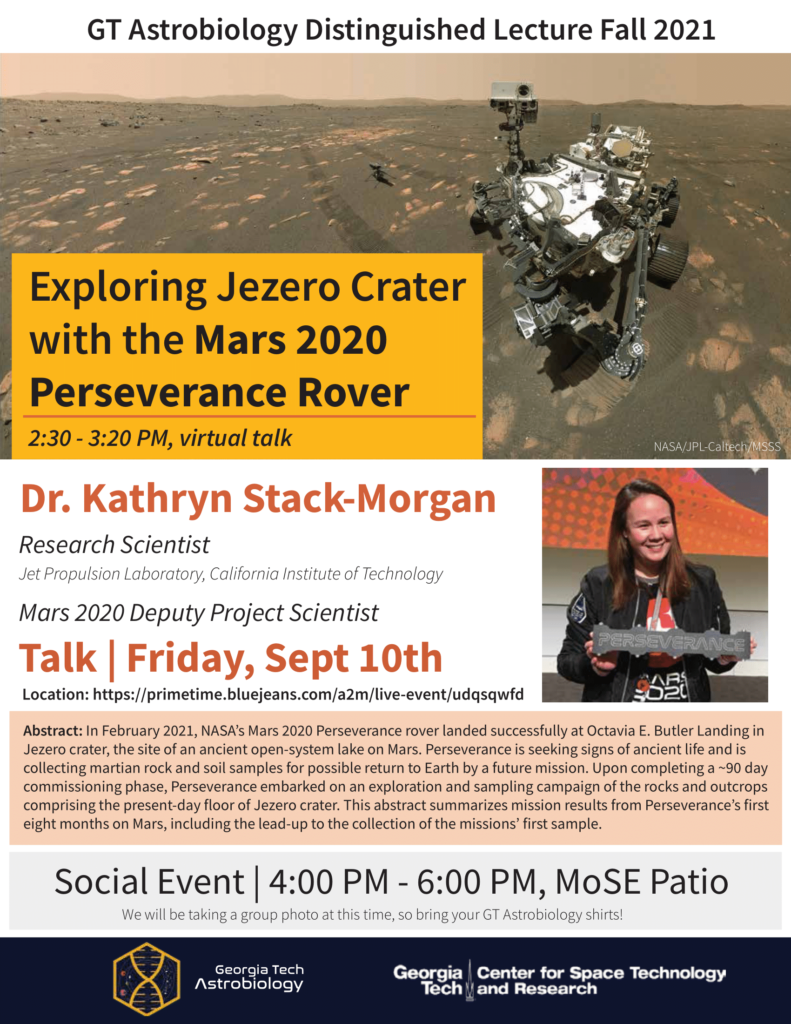
Dear Astrobiology, Origins, and Space Enthusiasts,
The ExplOrigins early career group invites you to join the 2022 Exploration and Origins Colloquium on Febuary 17th–18th, 2022!
The virtual event link is here: 2022 Explorgins Colloquium Bluejeans Event
General registration and abstract submission are through this form. All Early career individuals are highly encouraged to submit abstracts, due by the end of the day on February 4th.
We are thrilled to announce that Dr. Amy Mainzer will be one of our plenary speakers. Dr. Mainzer has done amazing asteroid research and telescope component engineering along with astronomy outreach to children, so be sure to register for the colloquium to hear her talk!
The program for the event can be found at the link below.
2022 ExplOrigins Colloquium Program
Preliminary Schedule:
Thursday, Feb. 17th Location: MoSE Atriums 3 & 4 | ||
Time | Event | Speaker |
5:00 – 6:00 p.m. | Poster Session | – |
Friday, Feb. 18th In-person location: Suddath Room, IBB | ||
Time |
Event |
Speaker |
10:00 a.m. | Welcome Speech, Breakfast | Tyler Roche |
10:10 – 11:00 a.m. | Talks Section 1: Clathrates, Cubesats, and Characterization | Christina Buffo
|
| Bacterial Clathrate-Binding Proteins in the Deep Subsurface Biosphere: Implications for Gas Clathrate Stability and Habitability | Abigail Johnson (Virtual) |
| Virtual Super-Resolution Optics with Reconfigurable Swarms (VISORS): a Two-CubeSat Formation-Flying Telescope for Coronal Observation | William Rawson |
| Characterization and Thermal Analysis of Metal Phosphites and Their Role in Astrobiology | Kimberly Faye Meyberg |
11:05 a.m. – 12:00 p.m. | Talks Section 2: All about Mars | Taylor Plattner |
| Geochemical and Mineralogical Evidence Against Hydrothermal Conditions in Eridania Basin, Mars | Emily Hughes |
| Modeling the behavior of mud flows on Mars | Abigail Russ |
| Testing the Hypothesis of Ancient Volcanism in Arabia Terra, Mars | Grace Fanson |
12:00 – 1:00 p.m. | Lunch Break |
|
1:00 – 2:00 p.m. | Keynote | Dr. Amy Mainzer |
2:00 – 3:05 p.m. | Talks Section 3: Inside Cellular and Molecular Evolution | Jordan McKaig |
| Molecular Memory at the Emergence of Life | Kavita Matange |
| Experimental Predictions of Ribosomal Evolution | Jay Haynes |
| Using the S. cerevisiae mitochondrial ribosome as an orthogonal evolvable translation system | Brooke Rothschild-Mancinelli |
| The Dual Origins of Phototrophy Reveals the Importance of Evolutionary Priority Effects in Major Transitions | Anthony Burnetti |
3:05 – 3:15 p.m. | Astrobiology Certificate Ceremony & Closing | Dr. Jennifer Glass & Dr. Frances Rivera-Hernandez |

More Info:
This colloquium will have events on two days: a poster session on Feb. 17th and talks on Feb. 18th. The posters session and talks will be held in person at Georgia Tech, and the talks will have a virtual viewing option. Our aim is to highlight work involving space exploration, biological, geological, and astronomical origins, and astrobiology from any field in the Atlanta area. Through this colloquium, we hope to:
- Forge relationships between diverse individuals of various fields, experience levels and backgrounds
- Expand our internal awareness of local work and innovations
- Encourage collaboration and interdisciplinary understanding
- Provide a professional growth opportunity for early career individuals including undergraduates, graduates, and post-docs
Past submissions have come from Earth and Atmospheric Sciences, Chemistry & Biochemistry, Biology, Physics, Mathematics, and multiple engineering and other departments. We are also continuing our encouragement of a wide breadth of topics, with examples from previous years ranging across mathematical orbital dynamics modeling, the ancestral ribosome, mission architecture design, and early Earth atmospheres, and we hope to see an expansion of subjects in this coming year. If you’re not sure whether your work is related, submit it!
ExplOrigins’ inclusion of a wide breadth of topics joins our commitment for inclusion across race, gender, age, religion, identity, (dis)ability, sexual orientation, and experience.
If you have any questions regarding the abstract submission process, please email the conference organizers at gtexplorigins@gmail.com.
Thank you for your consideration. We hope to see you there!
Sincerely,
The organizing committee
Christina Buffo, Chase Chivers, Rebecca Guth-Metzler, Jordan McKaig, Tyler Roche, Taylor Plattner, and Julie Yan.



